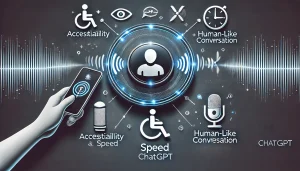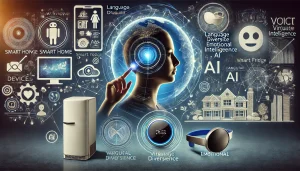Hi! I’m Taishi!
Recently, I’ve been very impressed by ChatGPT’s new function, ChatGPT’s Advanced Voice Mode so in this article I’d like to share some information not only about ChatGPT advanced voice mode, but also about the history of audio AI and its future.
By the way, if you’re interested, please check my previous post here about other voice AI.

Part 1: The Journey of AI Communication: From Typing to Speaking
Artificial intelligence has steadily advanced over the years, transforming how humans interact with technology. Among the leaders of this evolution is ChatGPT, a groundbreaking AI model renowned for its ability to engage in text-based conversations. However, the recent unveiling of Advanced Voice Mode marks a turning point in this journey—elevating ChatGPT from a powerful text assistant to a conversational partner that listens, understands, and speaks.
While typing to communicate with AI has been effective, voice interaction unlocks an entirely new level of engagement. Advanced Voice Mode introduces a more natural, fluid way to interact with machines, making conversations feel personal and authentic. Speaking to an AI, rather than typing, allows for faster and more expressive exchanges, mimicking the ease of a human-to-human conversation.
What makes this shift significant is the expanded accessibility voice interaction provides. For individuals with physical limitations or those in situations where typing isn’t practical, voice capabilities remove barriers. This not only makes AI more inclusive but also enables real-time, hands-free interactions that fit seamlessly into everyday life. ChatGPT’s voice mode represents a transformative moment in AI, reshaping not only how we engage with technology but also how we imagine its potential.
I used this function as the video below…!!!
Part 2: What Makes ChatGPT’s Advanced Voice Mode Revolutionary?
At the heart of ChatGPT’s Advanced Voice Mode lies a sophisticated blend of cutting-edge technologies. The first pillar of this innovation is speech recognition, allowing ChatGPT to listen with remarkable precision. Whether it’s recognizing different accents, dialects, or conversational nuances, the AI deciphers spoken input with impressive accuracy, ensuring conversations flow smoothly.
Once ChatGPT processes the input, it generates responses that sound human-like—thanks to natural language generation technology. This creates conversations that not only make sense but feel personal and engaging. Unlike rigid, robotic speech, ChatGPT’s responses carry a conversational tone, ensuring users feel like they’re speaking with an understanding partner rather than a machine.
So, what sets this technology apart? Let’s explore the key benefits:
- Faster, Hands-Free Communication: In moments where typing is inconvenient—whether driving, cooking, or multitasking—voice interaction proves invaluable. Users can interact without ever needing to touch a keyboard, speeding up communication in practical, everyday scenarios.
- A More Personalized Experience: ChatGPT’s voice mode allows users to experience conversations with depth. Tone, pace, and emotion come alive in ways text simply can’t capture, making the interaction richer and more relatable. For tasks like customer service, education, or therapy, this nuanced communication adds tremendous value.
- Widened Accessibility: Voice-enabled technology opens up opportunities for individuals who face challenges with traditional interfaces. Whether due to visual impairments, motor disabilities, or simply convenience, voice accessibility ensures AI becomes an inclusive tool for all.
- Versatile Applications Across Industries: The potential use cases are vast. Smart home devices, virtual assistants, content creators, and educational tools stand to benefit from this advanced voice capability. Whether automating tasks or offering personalized, voice-driven experiences, the flexibility of ChatGPT’s voice mode positions it as a vital tool across multiple sectors.

Part 3: The Road Ahead for ChatGPT’s Voice Capabilities
ChatGPT’s Advanced Voice Mode is a landmark achievement, but the exciting part is what lies ahead. This innovation offers a glimpse into the future of AI-driven voice technology, where even greater possibilities are just on the horizon.
- Multilingual Mastery: One of the most anticipated developments is real-time multilingual support. ChatGPT could soon be fluent in numerous languages, allowing seamless global communication without the need for translation apps. This advancement would eliminate language barriers for businesses and individuals alike, expanding ChatGPT’s role on an international scale.
- Enhanced Emotional Understanding: The future of voice AI could include detecting and responding to emotions. Imagine a scenario where ChatGPT picks up on subtle cues in a user’s voice, like frustration or excitement, and adapts its responses accordingly. This kind of emotional intelligence would create deeply empathetic interactions, particularly in areas like customer service or mental health support.
- Ubiquitous Integration: As smart technologies evolve, we can expect to see ChatGPT’s voice mode integrated into every aspect of daily life. From managing household appliances through voice commands to controlling wearable tech, the potential applications of voice AI are virtually limitless. Soon, ChatGPT could become your everyday assistant, seamlessly operating in the background of both your personal and professional life.
- Personalized Voice Options: Another exciting prospect is voice customization. The ability to tailor ChatGPT’s voice—choosing the tone, pitch, or even personality—would allow for a more personalized experience. This could lead to AI that truly feels like an extension of oneself, creating a more engaging and unique connection between users and their virtual assistants.
The horizon of ChatGPT’s Advanced Voice Mode is filled with promise, signaling a future where voice-powered AI will become indispensable. The rise of conversational AI will fundamentally change the way we interact with machines—making them more human-like, intuitive, and impactful.

Conclusion: ChatGPT’s Voice Mode is Shaping the Future of AI
The introduction of ChatGPT’s Advanced Voice Mode isn’t just an upgrade—it’s a reimagining of how we communicate with AI. This technology not only enhances convenience but reshapes the way we think about digital interactions. By transitioning from text to voice, ChatGPT has taken a monumental leap toward creating AI that feels less like a tool and more like a conversational partner.
As we look ahead to future innovations, from emotional intelligence to multilingual fluency, it’s clear that voice-enabled AI is poised to become a driving force in how we navigate the world. ChatGPT’s voice mode is already showing us what’s possible, and as it evolves, we can expect it to revolutionize not only the AI landscape but how we live and work.

